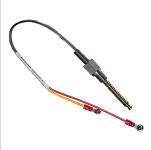Freemasm
Well Known Member
The question is not about extension lead materials, TC theory, cold junctions, etc. You basically have to introduce a junction in engine TC leads. Whatever you wind up doing will introduce some error. Easy to come up with an argument for/against any approach. What have people done to make splices that have a live-able installation?
- EI cold splice hardware. I want to believe this will be acceptable, 20 for $20 includes shipping and the odd sized allen wrench.
https://iflyei.com/product/olc-2/
- The "standard" Alcor TCs come with crimped-on ring connectors on the leads (see pic). Crimp or solder matching crimp rings to the extensions?
Other approach? What has been done here to prove reliable, close enough, measurements?
Your help. comments would be appreciated
- EI cold splice hardware. I want to believe this will be acceptable, 20 for $20 includes shipping and the odd sized allen wrench.
https://iflyei.com/product/olc-2/
- The "standard" Alcor TCs come with crimped-on ring connectors on the leads (see pic). Crimp or solder matching crimp rings to the extensions?
Other approach? What has been done here to prove reliable, close enough, measurements?
Your help. comments would be appreciated





